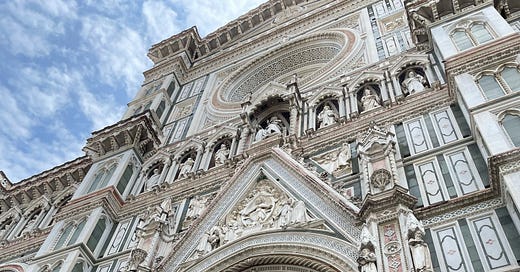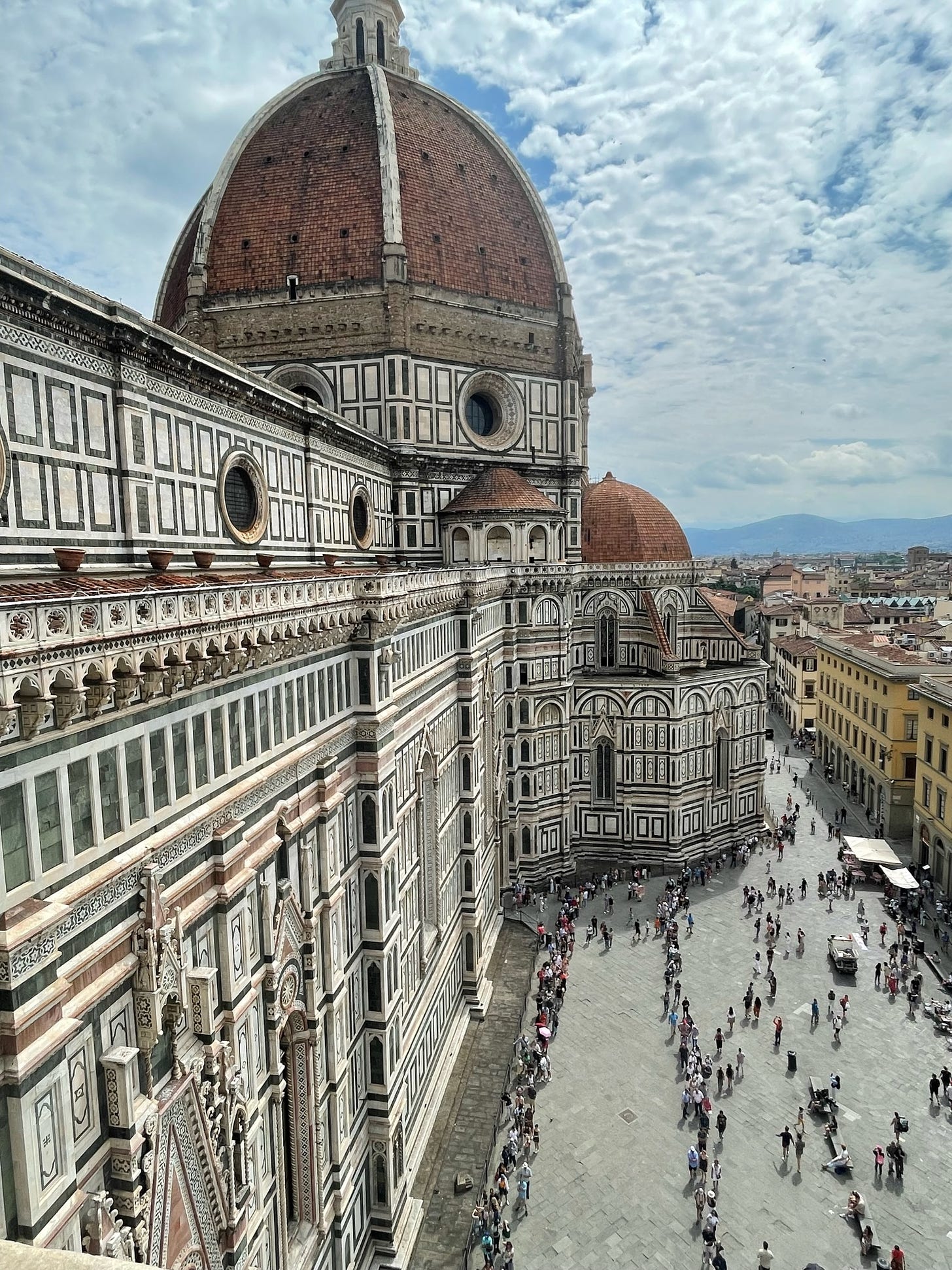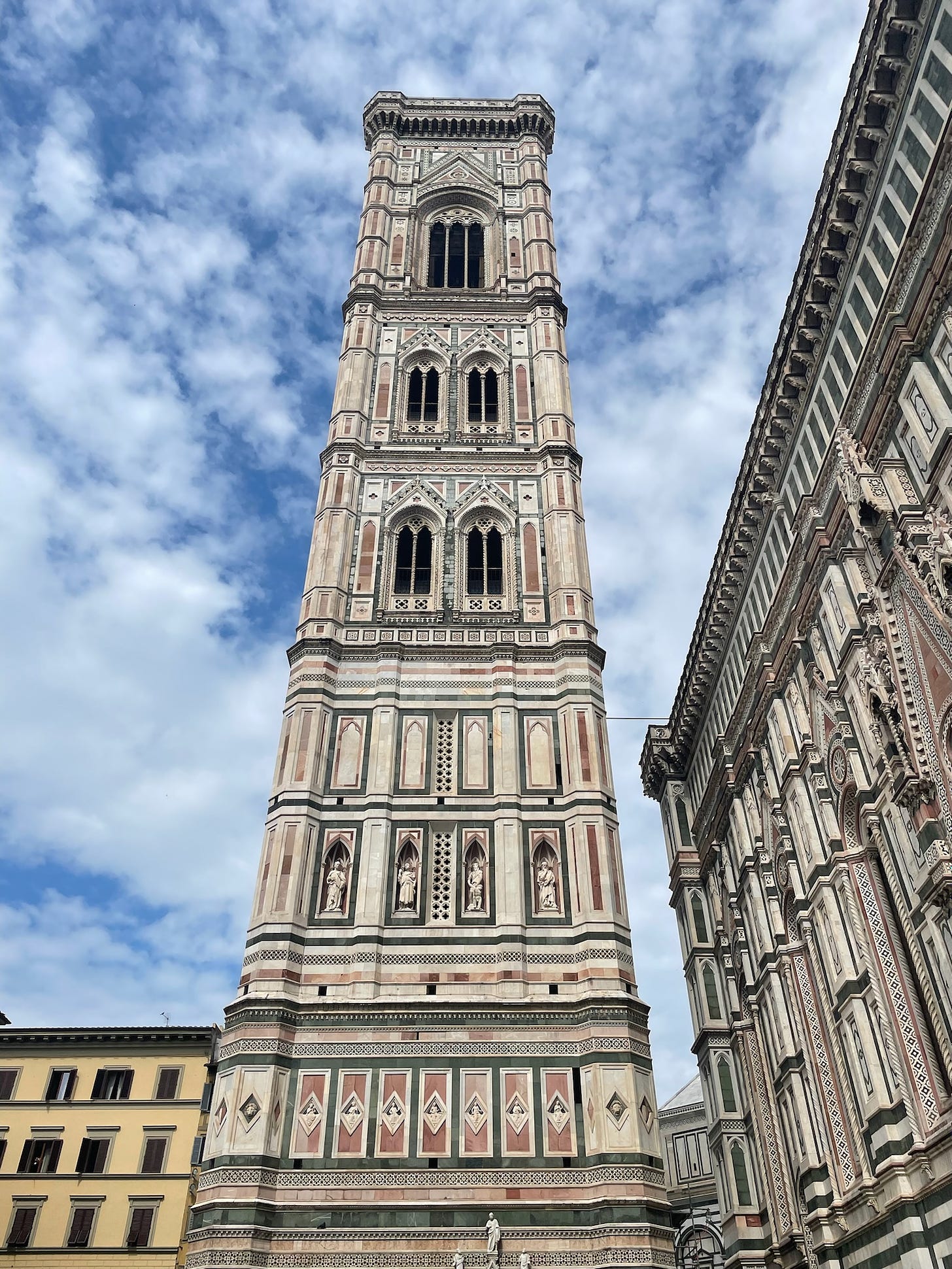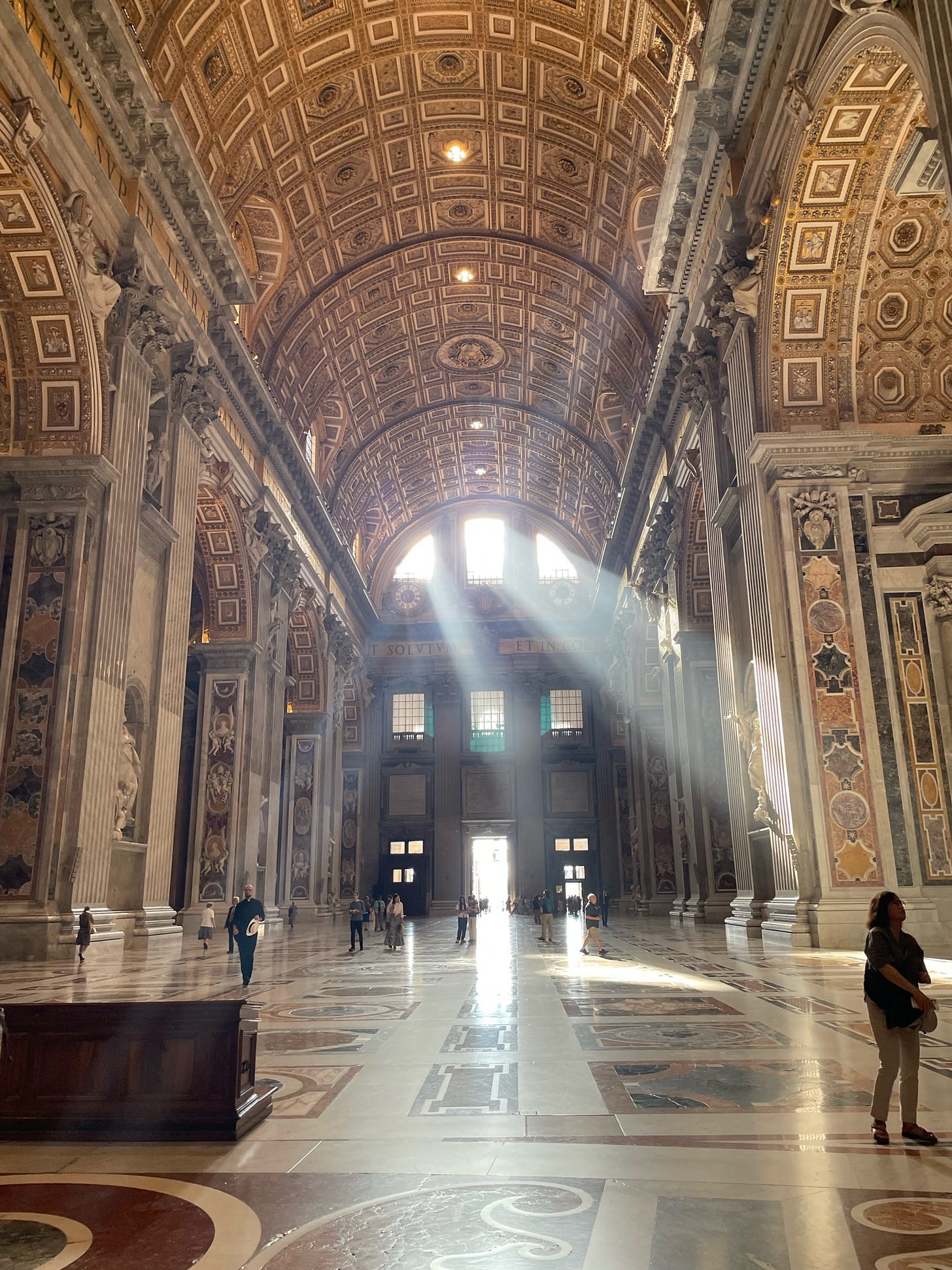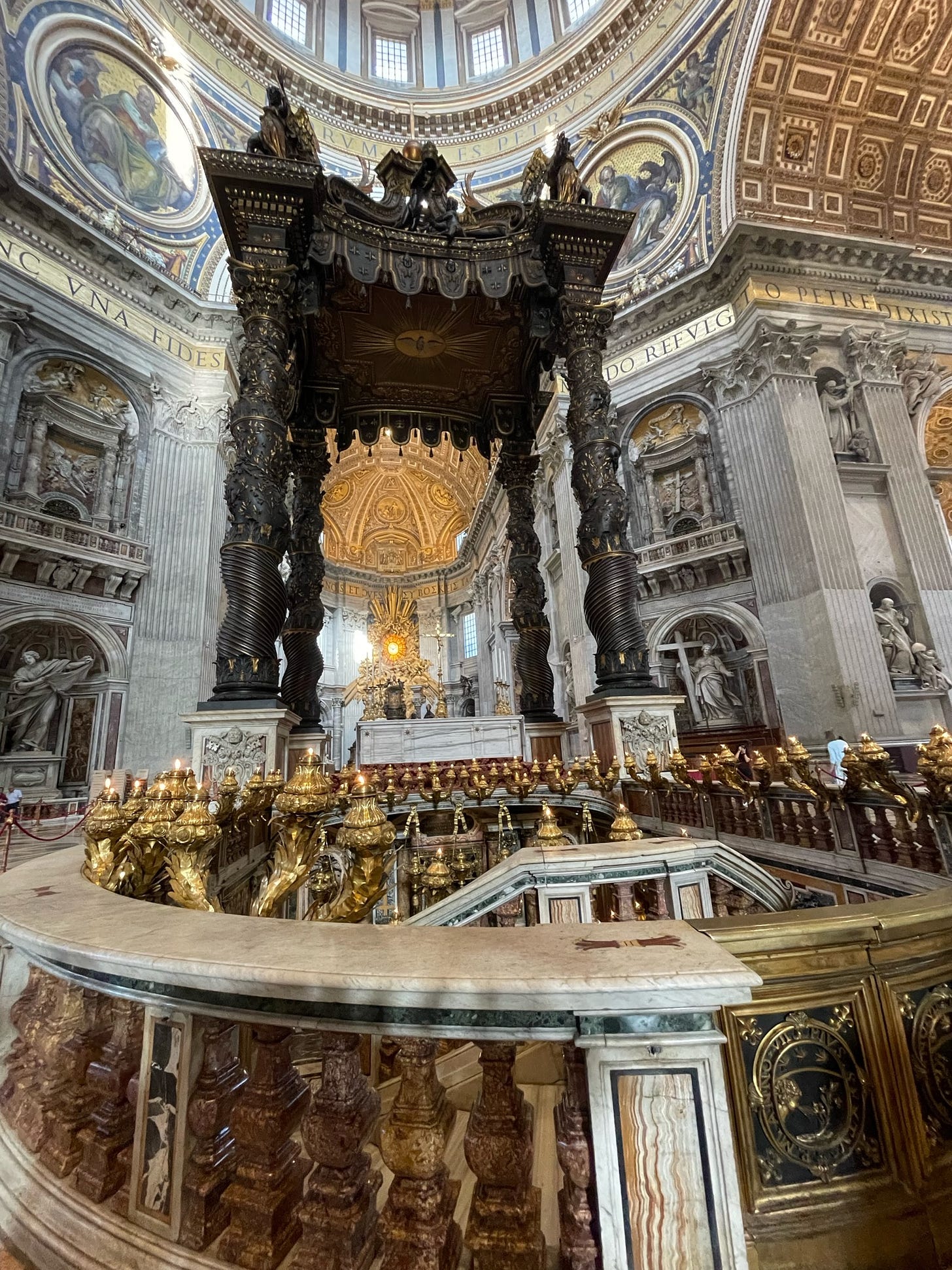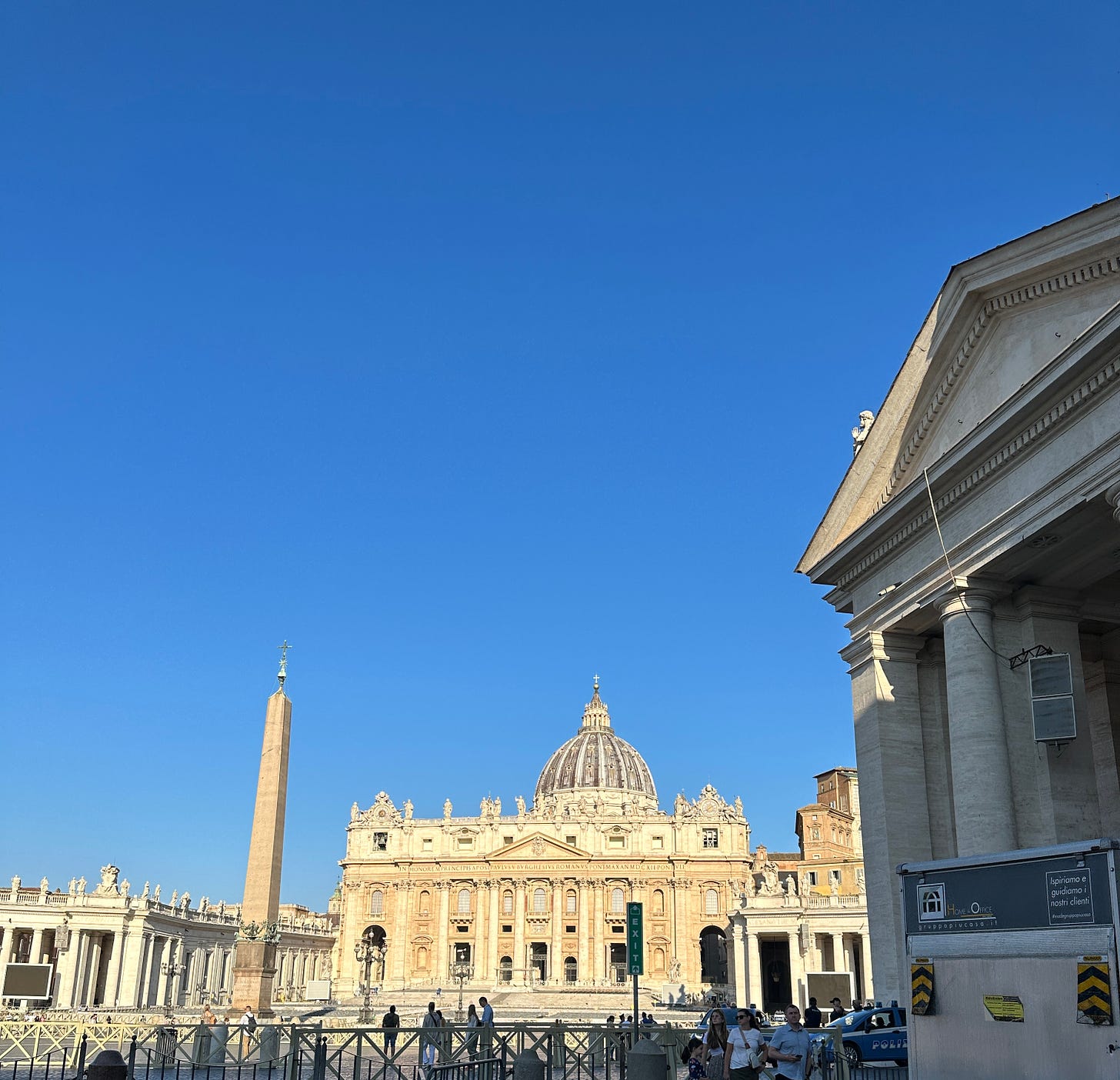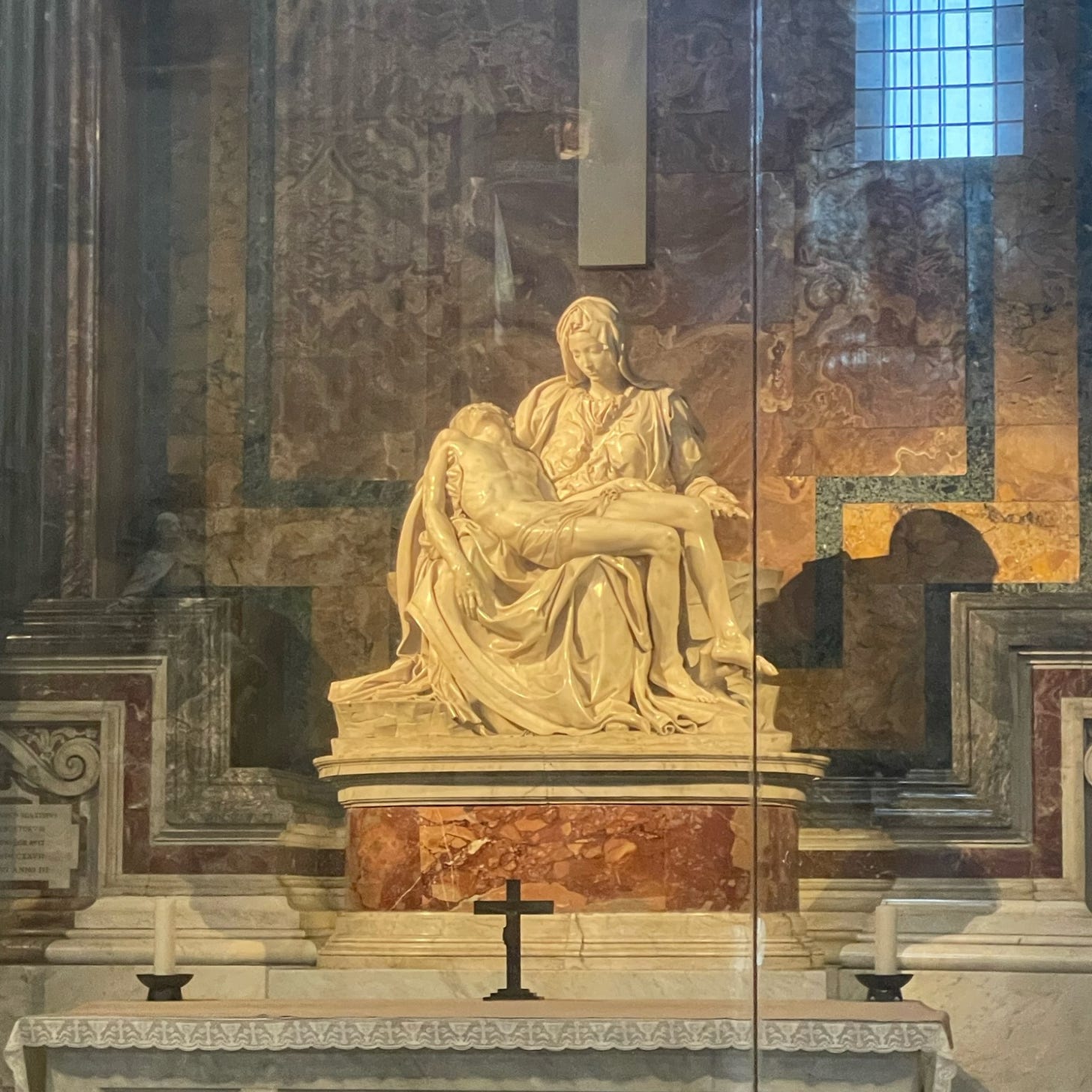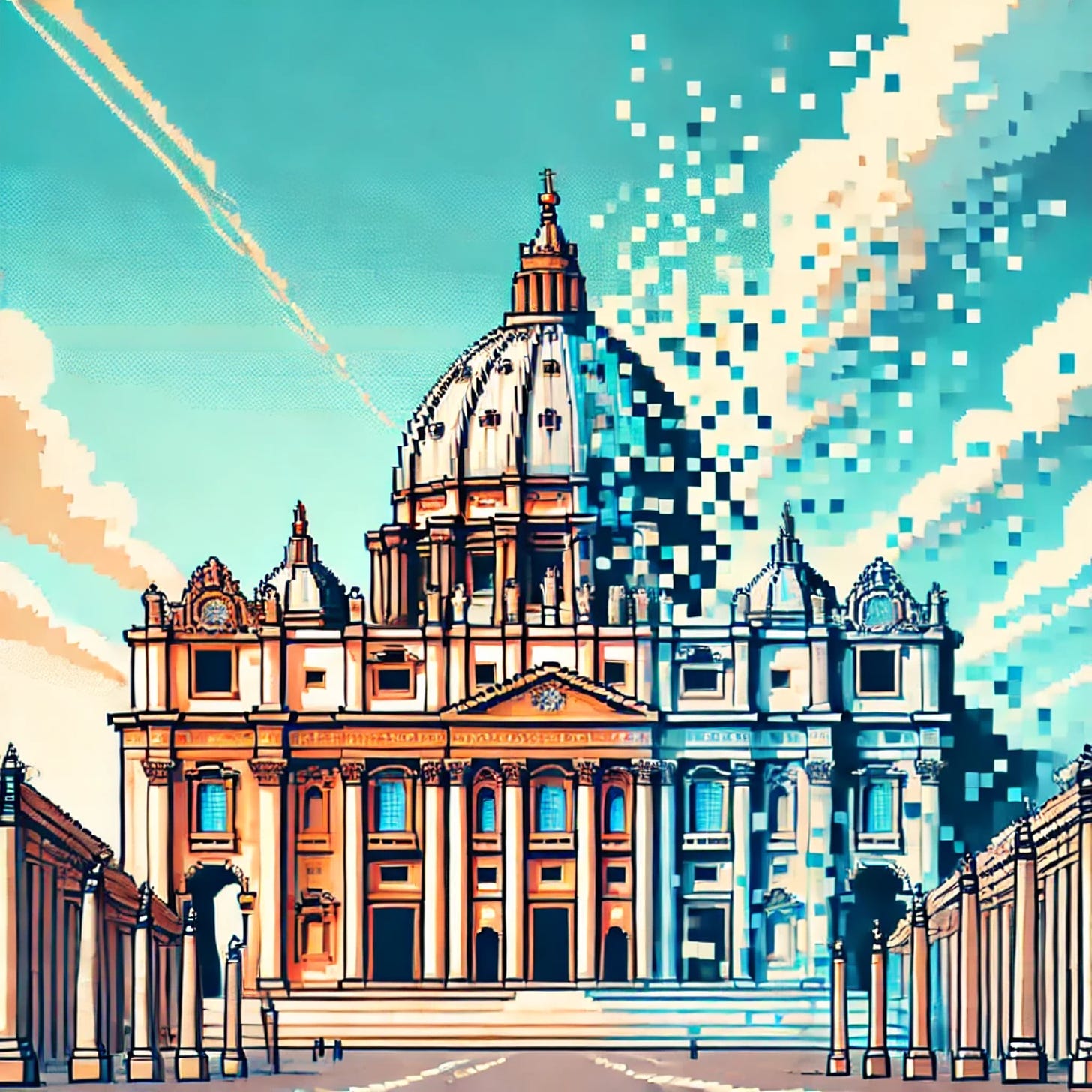Beauty without displays the ugly within.
My family trip to Italy was never short of undeniable beauty.
Through the 15 cities we visited in Italy, even the most unassuming churches revealed intricate detail and magnificence.
The sublime aesthetic and precise design of the Florence Duomo was almost too unbelievable to take in. Construction took over 140 years and spanned five architects1, a level of commitment not common to modern men and women. I could feel the depth of inspiration and commitment as I waited in line to climb Giotto's Tower.
St. Peter's Basilica is the pinnacle of beauty, standing out foremost among other sites throughout Rome - a daring statement to make.
I was struck with the solution that my creative work needed to be guided by the beauty and meaning that I witnessed in these cathedrals.
I had been grappling with this idea before we left for our two-week trip to Italy.
The standard ‘9-5’ employee model was never appealing and certainly not a permanent solution. I have found myself in one, though, and I am making the most of it. I studied accounting at university for practical reasons, primarily financial stability. I achieved the last remnant of this pursuit by acquiring my CPA in June 2021. Since then, I have been pursuing the professional and creative journey that awaited me on the other end.
From June 2021 to June 2023, everything about my creative endeavors was about growth hacking, being fast-paced and hyper-rational, following social-media guru insights, continually optimizing, and posting rigorously often while still being honest. I figured this was the most reasonable route to self-employment.
The trip to Italy transformed my outlook on work and my approach to life in general. The sheer amount of effort and collective life commitment that people imbued into creating these stunning cathedrals influenced me profoundly.
Beauty is a mirror from which your imperfections are made clear to you.
This idea is brilliantly explored in Lex Fridmans opening question in his interview with Jordan Peterson.
The most beautiful things tend to be reflective, which was the case for me during and after my return from Italy.
I was confronted by my imperfections and was inspired by what I saw.
The question rattled within me: How can I structure my pursuit to embed an awe-inspiring grandeur and meaning pertinent to these beautiful cathedrals in my creative work?
I want to relay my findings to this question and jointly explore where our modern society needs more of this beauty—in digital spaces.
Building My Cathedral
My sister, who had been to Italy before, relayed helpful information to us for the next day: We must get to St. Peter's Basilica early if we don't want to wait in line all day. We arrived at St. Peter's Square around 7:30 a.m.
As we gathered in line, I noticed a mother and daughter anxiously waiting for someone. Frequently checking over her shoulder, the mother clutched at her rosary, speaking Spanish to her daughter in a worrisome tone. The mother let us go ahead of her as we arrived at the security checkpoint, mentioning that she was waiting on her two sons - who came shortly after that.
As we made our way up to the Basilica doors, I peeked over my shoulder to see the mother ripping her two sons a new one, who both held their heads in shame. I continued forward, and no amount of pictures or words could prepare me for what was inside. I was immediately stunned by the cathedral's beauty as my eyes met the wonders that lay within. I felt a sense of safety—as if I could sit in the cathedral and spend an eternity in meditation.
I strolled through, relishing in the splendor, and made my way around to a statue near the entrance.
This statue was Michaelangelo's Madonna della Pietà.
In my line of view of the statue were three people - the mother and her two sons.
Interestingly, she was whaling! It looked to me like she was releasing a deep cry, and her two disheveled sons comforted her in confusion. I had some vague insight into why it may be the case that she erupted into tears at this statue!
I was reminded of JBP's Psychological Significance of the Bible lecture series.
In it, he makes the case that this statue is a phenomenal representation of the archetypal Great Mother and the most brutal sacrifice they must make: Offer their kids up to the world.
In all its destruction, horror, and malevolence, the world is a fearful place for a mother to uncloak her children and let them engage in the adventure of their lives—hence Freud's identification of the archetypal mother complex.
I don't know if this was the case for this mother. Still, I thought I saw an unbelievably deep work of art speaking to her and communicating this eternal message. My brief observation of her and her sons indicated there might be truth to it.
Art that is beautiful enough to bring us to tears communicates to some part of us that we don't quite fully grasp but seems to be attempting to help us transcend.
Through reading Jung, I have started learning about the importance, depth, and significance of one of the ways great art communicates - through symbols.
Symbols are not consciously deliberated artistic creations; rather, they are something of human nature, manifested of their own accord and communicated to us through our unconscious, mostly in the form of dreams. These parts of us are so deeply rooted that laying our eyes upon an archetypal symbolic statue is enough to evoke tears in an internal plea for reflection.
Our unconscious minds have a collective nature that communicates messages that we need to consume, and the conduits of these messages are the most creative humans.
Walking through the cathedrals of Italy and my newfound knowledge of deep imagery, such as the Pieta, communicated a message to me that struck me with a necessary piece of inspiration:
No matter how long it took, no matter how much suffering was required, and no matter how close it brought me to death, I needed to create something deeply human2—something that resonates on a fundamental level and speaks to the core of our shared experiences—and meaningful enough that people are willing to make pilgrimages, digital and physical, to engage with the beauty I put into the world, now and forever.
I want people to come to my creations as they come to cathedrals, seeking knowledge, beauty, connectedness, and meaning.
The most beautiful things are beautiful down to the most minor constituent parts, and my life's journey has taught me the need to pivot into making meaningful written and spoken creations at this level. If even one person reads my work and walks away with a sense of inspiration, I am moving in the right direction.
When I started writing this piece, I researched what we would say our "modern cathedrals" are. The best exploration I could find of this was by Tom Pueyo, Cathedrals of the 21st Century, Who brilliantly lays out the cathedrals of the past and present, from Pyramids to churches to skyscrapers to trading floors to airports and nightclubs.
One critical modern cathedral is not well explored - the ones that exist in the digital space, or more precisely, need to increasingly exist in the digital space.
I'm not saying that the digital spaces we inhabit must bring us to tears and mimic the beauty of one of the greatest sculptors of all time—but where is the beauty that communicates to the deepest parts of humanity, like this mother in the cathedral?
Where is digital beauty?
Bits - The Modern Cathedral
Frederik Gieschen highlights something fundamentally true about the digital sphere of existence in his piece How the Search for Secular Cathedrals Is Emptying Our Wallets Without Filling Our Hearts. He writes
In his new book about the impact of smartphones and social media, The Anxious Generation, Jonathan Haidt outlined six universal spiritual practices, namely "shared sacredness; embodiment; stillness, silence, and focus; self-transcendence, being slow to anger, quick to forgive; and finding awe in nature." These spiritual practices are the "opposite in almost every respect" of life in the digital realm which is "disembodied, asynchronous, shallow, and solitary.”
I've previously explored that social media is causing not only a mental health crisis flagged by Jonathan Haidt but also a less discussed creator's loss of self. The problem is that creators modify art, words, and behavior for an algorithm to receive a desirable outcome, changing the creators themselves to be slaves to the algorithm rather than arbiters of their internal beauty.
Our new world contains modern cathedrals, yet the places we spend the most time- our digital worlds- do not possess the significant elements of cathedrals.
Our digital realm is due for an overhaul.
We forget that software is an extraordinarily new phenomenon relative to the human experience, and it's more likely that the original pioneers didn't hit the nail on the head on the beauty front.
True that free markets will fulfill people's needs, but unfortunately, people fall in love with life-debilitating drugs and have a hard time fleeing before it's too late - an effect all too akin to social media platforms.
That statement is a bit facetious - I want to be clear that I love our current social networks, such as YouTube, Substack, Twitter, and the like. In seconds, I can connect with some of the most brilliant and authentic minds on the planet. I do think that using these platforms can actually help build a new paradigm of the internet, which I will talk about in an upcoming piece. However, we have moved in the wrong direction.
Software cathedrals will likely need an underlying infrastructure method and process to exist first.
As Packy explored in Make the Internet Fun Again, the internet feels broken, permeated by slop, "mediocrity in pursuit of metrics." His suggestion is that what comes next will start by looking like a toy, as Chris Dixon lays out. He highlights the creation of websites and 3D worlds that are so fun that they don't need to be SEO optimized, but rather, people will seek them out. Oncyber (a portfolio company of his VC firm) was highlighted as an infrastructure provider for these websites. It is actually pretty cool if you look at the website they spun up for NotBoring (a similar copy of the famous Nintendo Family Office website).
I think making the internet fun is a good solution; making it fun and beautiful is a great one.
While the potential of digital cathedrals is vast, it's essential to recognize the challenges in redefining spaces that have become so deeply ingrained in our daily lives. Yet, it's in addressing these very challenges that the most meaningful transformations occur.
How might one build their own digital cathedral?
For starters, we should approach the internet with a first principles view and start by asking ourselves better questions. We should start at the top level of companies with more noble aims over profitability (while still producing profits) and retool the algorithms to favor beauty and authenticity in creation. Creators must not bend themselves for the algorithm and rather stick to the true intention of their creations. I think practical tools like Oncyber provide infrastructure for builders, and 'social media' like Cosmos are good sources of inspiration and areas where people are trying to ideate what this future internet might look like.
Upon entering some of these URLs, I hope to be awe-struck and stay around because I feel some of the six universal spiritual practices, not because I can't control myself and am addicted to the next post or video in my never-ending feed.
Two weeks in Italy and many cathedrals later, I was stunned by what I saw.
This inspiration served as a perfect complement to the struggles I had been pondering.
In real-time, I believe I saw an eternal message communicated through beautiful art, evoking a deep emotional response.
I can’t help but think that we need to see things like this to retain our humanity - and where better than in our digital spaces.
I love spending time in digital spaces and interacting with technology, which I think is a beautiful feat of mankind.
But in the same way that I didn't want to leave St. Peter's Basilica, I hope that we can create an improved era of digital creation where I don't want to leave because of the beauty and not because I'm on a heroine drip from the moment I enter to the second I leave.
While I've noted Oncyber and Cosmos and linked some more examples below - this is only beginning to take shape. As uncovered by popular business thinkers, new paradigms usually start by looking like a toy. What might look like a toy now can become the next digital paradigm.
If you made it to the end of the essay, I hope I managed to embed a level of beauty and meaning that made sticking around to the end worthwhile.
If so, subscribe for more - we're only beginning on this journey, and I would love to have you on board :)
Until next time, take care of yourself, everyone
Dom
Here are some great examples of websites and artists in the digital sphere that evoke the described feeling:
https://lorenzo-bernini.com/
https://chia.design/
A lot of the links in this piece as well:
https://public.work/
https://www.cosmos.so/home
https://y-n10.com/
What examples of digital creations evoke inspiration and awe in yourself?
https://en.wikipedia.org/wiki/Florence_Cathedral#History
Creating something that resonates profoundly with the core aspects of human experience and emotion. Crafting an artifact, idea, or work that captures the essence of what it means to be human—encompassing universal themes such as love, struggle, beauty, and connection. The goal is to create something so impactful and meaningful that it inspires people to seek it out, both digitally and physically because it touches on fundamental human truths and emotions that are timeless and universally understood.


